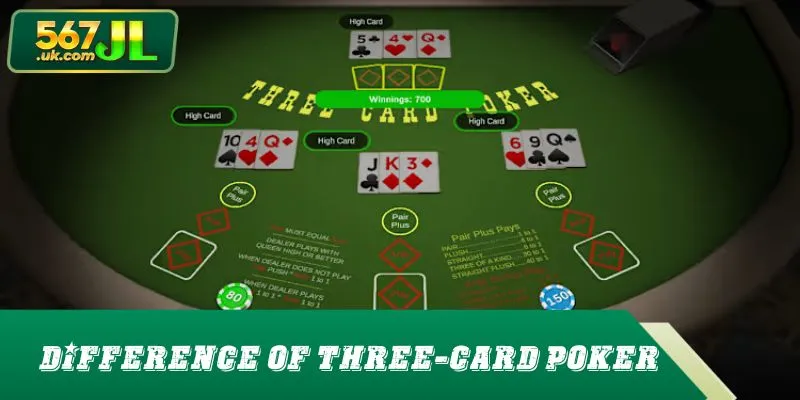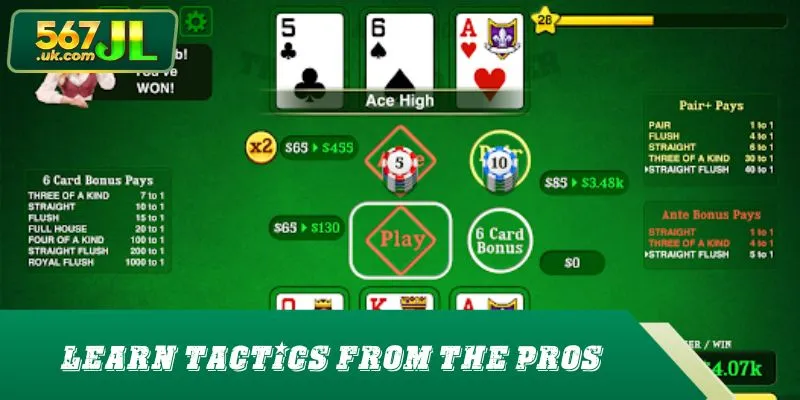If you’ve ever been curious about a fast, exciting version of poker that doesn’t require hours of strategy or reading opponents, Three-Card Poker might be the perfect fit. In this complete beginner’s guide by 567JL, we’ll walk you through exactly how this popular casino game works, how to place your bets, and when to make the right move.
Contents
What makes Three-Card Poker different from other

Three-Card Poker may carry the poker name, but its gameplay is closer to a table game like blackjack than traditional poker played against multiple opponents.
A casino game with poker roots
You’re not trying to beat a table full of players – your only competition is the dealer. Each round of Three-Card Poker starts with you receiving just three cards. The dealer gets three cards, too – face down. Your goal is to make a better hand than the dealer based on standard poker rankings (adjusted for three-card hands).
But that’s not the only way to win. The game also includes optional side bets that reward high-ranking hands no matter what the dealer shows. This simplicity – a single decision point, fast gameplay, and multiple ways to win – is what sets Three-Card Poker apart from its more complex relatives.
A game designed for speed and simplicity
The modern version of Three-Card Poker was developed to give players a poker-style game that didn’t require long rounds or deep decision trees. Unlike Hold’em, where you might spend ten minutes analyzing one hand, its hands are resolved in under a minute.
This makes it ideal for beginners or casual players who want an easy-to-understand experience with the excitement of potential high payouts.
Play Three-Card Poker – Full rules and round structure

Here are the rules of the game. This signals that you’re in the hand and ready for the showdown.
The initial bet and deal
The game begins with the player placing an ante – a standard starting wager. In most versions, you can also place a Pair Plus side bet at this time, which is optional. After the bets are placed, both the player and the dealer receive three cards each. Your cards are dealt face up, while the dealer’s cards remain hidden until the end of the round.
Now, with your three cards in front of you, you must decide whether to fold or continue the hand. If you fold, you lose your ante. If you believe your hand has potential to beat the dealer’s, you make a “play” bet – which is equal to your ante.
When the dealer reveals their hand
After all decisions are made, the dealer flips their cards face up. But here’s the twist: the dealer must “qualify” to compete. In Three-Card Poker, the dealer qualifies only if their hand contains a Queen-high or better. If the dealer doesn’t qualify, your play bet is returned to you, and your ante wins at even money.
If the dealer does qualify, then the hands are compared. If your hand beats the dealer’s, both your ante and play bets are paid out at even money. If the dealer’s hand is stronger, you lose both bets. It’s a simple win/lose structure, but with a unique rhythm that keeps players engaged.
The pair plus bet – A chance for bigger rewards
One of the standout features is the Pair Plus side bet. This optional wager lets you win regardless of whether the dealer qualifies or beats your hand. The payout is based solely on the quality of your cards. If you place a Pair Plus bet and your hand contains a pair or better, you receive a payout – even if the dealer has a better hand.
Payout rates vary depending on the casino, but typical rewards include: Pair: 1 to 1 Flush: 3 to 1 Straight: 6 to 1 Three of a Kind: 30 to 1 Straight Flush: 40 to 1 This side bet adds excitement to each hand and gives players something extra to root for – especially during dry streaks against the dealer.
Understanding strategy in Three-Card Poker

Members need to grasp the experience from the experts:
The best time to play or fold
Although Three-Card Poker is simple, playing blindly every hand is not the best approach. Experienced players follow a basic guideline: only make the “play” bet if your hand is Queen-6-4 or higher. This isn’t just a rule of thumb – it’s based on mathematical analysis of long-term outcomes. If your hand is weaker than that, folding saves you money over time.
For instance, a hand like Queen-2-3 is too weak to continue, even if it looks promising on the surface. Of course, it’s tempting to chase a win or “just see” what the dealer has. But consistent use of the Queen-6-4 rule helps reduce the house edge and maintain a disciplined approach.
Pair plus: worth the risk?
Whether or not to include the Pair Plus bet depends on your appetite for variance. It carries a higher house edge than the base game, but the payouts are much larger. If you’re someone who enjoys the thrill of big potential wins – or if you’re on a hot streak – throwing a few chips at the Pair Plus can be worth it.
Just remember: it’s best to treat Pair Plus as a fun bonus, not your main betting strategy. It’s there to enhance the game, not replace it.
Managing bankroll and session play
Bankroll discipline is crucial. Since rounds move quickly and decisions feel easy, it’s common for new players to run through their chips faster than expected. Set a session budget before you begin and stick to it – regardless of wins or losses.
At 567JL, you can choose from different table limits. Start small to get comfortable, then gradually increase your wagers once you’re more confident. Never chase losses, and take breaks often. Three-Card Poker is fun, but like any casino game, it rewards calm, focused players more than impulsive ones.
Conclusion
Three-Card Poker is one of the most enjoyable, fast-paced games you can play in a casino – and online at 567JL, it becomes even more accessible. With simple rules, quick hands, and multiple ways to win, it’s a game that delivers excitement without overwhelming complexity.
